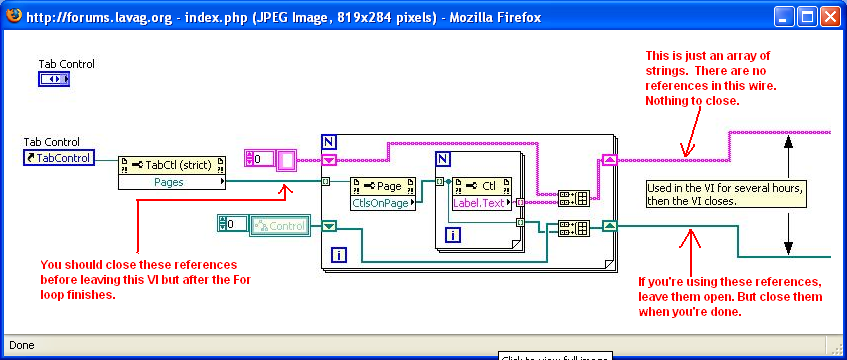-
Posts
257 -
Joined
-
Last visited
Content Type
Profiles
Forums
Downloads
Gallery
Posts posted by BrokenArrow
-
-
QUOTE (Michael Hill @ Apr 10 2008, 07:54 AM)
I'm using an NI PXI-1045 chassis connecting through a MXI-4 card to my computer (Running Red Hat 3). I can see all the cards with nipxiconfig. What I want to do is take samples from an NI 4070 DMM. However, when I try to intialize it with the name "PXI8::13::INSTR" (What shows in nipxiconfig for the 4070), I get a VISA error that states that "the given session or object reference does not support this operation". Please help!You still there?... :question:
Are you using "PXI8::13::INSTR" as the resource name? Go to MAX and look for the alias. It's likely to be something like "Dev1" or "PXI1Slot5" or something similar. Use that as the resource name.
-Richard
-
QUOTE (ASTDan @ Apr 21 2008, 05:01 PM)
Hello,Does anyone know if it is possible to print out your Project Folder for documentation purposes?
Is there another method/software tool of easily documenting the all the files that you are using for your applicaiton?
Thanks
Dan
I often wondered why Windows doesn't let you do this.
In DOS, just type at the command line "dir > whatever.txt" and the contents of the current directory will be printed to the text file whatever.txt. This has the advantage of giving you the file sizes in exact bytes.
Richard
-
reem,
For the port number, if you mean a serial port, you need the VISA resouce name control.
But like has been said, if you're struggling with data types.....
-
QUOTE (neB @ Apr 15 2008, 02:23 PM)
http://en.wikipedia.org/wiki/Flying_Spaghetti_Monster' rel='nofollow' target="_blank">or a LabVIEW programmer and beleive in a deity, as I choose to beleive
-Richard
-
Dang, I'm supposed to be the First Responder of the One Hit Wonder.
reem,
What Antoine said.
Attached is an example of a typical "cluster".

-Richard
-
QUOTE (BrokenArrow @ Apr 16 2008, 02:27 PM)
....MAX thinks I have a different version of NI-DAQ on the RT vs. Host.....This ended up being a known issue (known to NI at least) with the NI-DAQmx driver that ships with 8.5.1. If you use a DAQmx in a RT chassis, you should download NI-DAQmx 8.7.1f3 from NI.
Or (I guess) un-select the install of NI-DAQmx when you upgrade, thus leaving your NI-DAQmx as-is.
-Richard
-
Has anyone had issues with upgrading to 8.5.1? The install went smooth for me, although it took half a day to do two computers (hosts and RT's).
The only issue I have had is MAX thinks I have a different version of NI-DAQ on the RT vs. Host, so I can't make new DAQmx Tasks!

-Richard
-
My 2c on RT memory issues...
- Try disconnecting the error inputs on queues and notifiers. This is especially true if you believe the error cluster may be carrying a warning.
- Try placing queues or notifiers outside of case structures.
- Off the subject a bit, but don't use string shared variables in RT version 8.5
I have seen three separate RT memory leaks fixed by each bullet.
cheers!
- Try disconnecting the error inputs on queues and notifiers. This is especially true if you believe the error cluster may be carrying a warning.
-
This has happened to me on two systems using a DMM in the RT chassis but completely different code. Update to NI-DMM 2.8 before make RT EXE's.
cheers,
Richard
-
QUOTE (JOliver @ Feb 25 2008, 02:08 PM)
I have a servo motor with a serial interface and am trying to figure out how to read the serial port using an analog trigger event from the device that the servo motor is turning. Does anyone have an ideas? I am using a 9205 in a cDAQ for the analog input.Is it the wiring / hardware part that you have questions about, or the LabVIEW part?
The obvious solution is to have an event fire when the analog signal exists (i.e. what jdunham said), or when the signal crosses a certain threshold. Or you could use hardware handshaking. If you can convert the analog signal to digital (and that may not even be necessary depending on the level), you can wire the signal to the handshake line (CTS) and use VISA Enable Event and VISA Wait on Event to monitor the CTS line. When the signal exists, read the port.
Richard
-
-
Add me to the Tabbing camp. Armed with the Ctrl button tidbit, I'm going to give auto a try again. I'm not too concerned with the time I'm wasting hitting Tab, but I do waste 45 minutes a week telling people to turn autotool on if they sit at a computer I've been on.

-
QUOTE (mcguirpa @ Mar 11 2008, 06:04 AM)
...... But in a 20x20 array there's 400 possible locations, so I'll need 400 cases. Doable, but not pretty.....If you can provide code I (or someone) can likely help, but you might have to make the executive decision that doing it the ugly way gets the job done, and that by the time you get to the elegant solution, they've got your job on Monster. I'm positive that there's a better way to do it, but as you know, 400 cases involving insert into array or replace array subset (better) is a cakewalk for a Pentium processor. But your code will be ugly and hard to maintain.
Just heed this: Under almost not curcumstances should you build arrays of unknown size in loops.
-
QUOTE(Aristos Queue @ Mar 10 2008, 07:16 PM)
Wow Aristos, thanks a lot for your effort. Looks like I was 50% there, as I'm closing out the array of refs upon leaving the VI, but not the initial tab page references. I guess LabVIEW was doing that for me when the VI becomes idle, which it will for perhaps hours at a time.
Richard
-
QUOTE(mcguirpa @ Mar 7 2008, 10:38 AM)
Hi everyone, total newb to this.I've started writing a vi and pretty much got it doing what I want, but I want to make a few improvements and I'm not sure about how to go about it.
Part of my vi is attached. This loop takes data from an array where the user can specify which columns are passed to the loop. There is a bottle neck in initially passing the data to the loop as there is a sub vi which does some array maniupalation to put the data in a form suitable for plotting. So what I would like to do is to be able to simply load the data then have the user be able to clear the graph and replot various columns against one another without having to load all the data again.
There are some further things I would like to do, but a little less essential at the minute:
1. How do I vary the timing of the loop? One of the columns in my data is time, I have done a little routine to get the difference between each time (roughly 25 ms hence the delay of 25 ms in the loop) however when I try to delay each point by the 'real-time' delay I think all that is happening is that the loop is running right through with the first delay, then with the second delay etc. etc. Hope this bit makes sense

2. A density map. This data is time and location, what method would I use to make a plot of how long our tracer spends in each location over the course of a run? I have a rough idea that I would need to make a 2D array where each value corresponds to a location then loop through the location data and populate my array. Not sure what the best way to go about this would be though.
Anyways, any help appreciated

As far as number 1, the only way to vary the timing of that loop is to wire a control to the timer rather than a constant, or send a number to it programmatically. For example, the loop iteration (i) can be used with a scaler and fed to the timer. If you already know that stuff, then I probably didn't understand your question.
As far as number two, I can't tell what's happening from just the screenshot.
-
QUOTE(tcplomp @ Mar 8 2008, 06:00 AM)
Static References (those directly linked to a control) can't be closed. If you close the reference nothing happens. It would be like deleting the control itself.Ton
I'd like to ask what you (or anyone) thinks about the situation in the attached picture. This code gets references to 15 different array indicators (of type string, numeric, and boolean). So, do we just need to close the "Tab Control" reference? Perhaps even that isn't necessary? I'm a little fuzzy on what constitiutes a "branch", and if a reference to a control is the same as a reference to an indicator insofar as how it's treated in LV.
Thanks,
Richard
-
There's not much there. If you have any questions let us know.
-
It just depends on what colors you want. You can write an explicit color to a property node, or play with numbers to get the effect you want. Horizontal or vertical is of no consequence. I threw these two sliders together in a few seconds, but you'll get the idea (version 8.2 I think). I hope I understood your requirement.
Richard
-
QUOTE(Eugen Graf @ Mar 3 2008, 06:18 PM)
....... I don't know what to do with the cursor in the String Control. False implementation, any ideas?................I see... the string control thinks the data is fresh every loop iteration, causing the cursor to stay in position1. Maybe follow the string length and force the issue? See attached picture.
Richard
-
QUOTE(Eugen Graf @ Feb 22 2008, 08:14 AM)
Very nice looking - a great LV implementation of the familiar Hyperterm behaviour. My computer isn't finding the Exit If Runtime VI. From your user lib?
Richard
-
Dude chill. :beer:
-
Isn't the comma thing an artifact of the nationality of his LabVIEW version, and not so much a format deal?
-
What, exactly, is your issue at this time? Your timing will code work fine, there's no issues there. If you set it for 1 minute, it should run 1 minute plus maybe 100mS. Is your serial port code hanging up? Check and make sure you don't need to send a CR or LF with your commands.
Richard
-
Pick one.
-Richard




Problems with DAQ card
in Hardware
Posted
QUOTE (reem @ Apr 28 2008, 07:58 AM)
reem,
alzhrani's question was what type of physical card, in other words the DAQ itself. You've shown us a picture of the programming interface you are using, in this case an express VI.
There's no reason why you can't use Controls. I think you're missing something on a higher level.